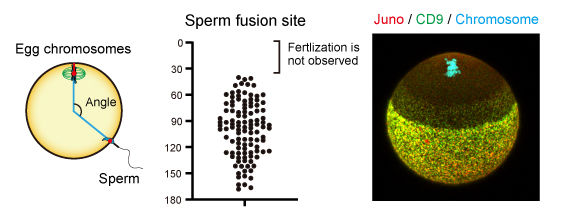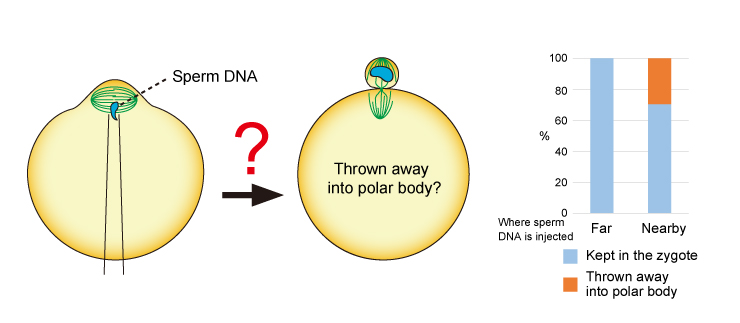RanGTP and the actin cytoskeleton keep paternal and maternal chromosomes apart during fertilization (Ikawa Lab, in Journal of Cell Biology)
Zygotes require two accurate sets of parental chromosomes, one each from the mother and the father, to undergo normal embryogenesis. However, upon egg–sperm fusion in vertebrates, the zygote has three sets of chromosomes, one from the sperm and two from the egg. The zygote therefore eliminates one set of maternal chromosomes (but not the paternal chromosomes) into the polar body through meiosis, but how the paternal chromosomes are protected from maternal meiosis has been unclear. Here we report that RanGTP and F-actin dynamics prevent egg–sperm fusion in proximity to maternal chromosomes. RanGTP prevents the localization of Juno and CD9, egg membrane proteins that mediate sperm fusion, at the cell surface in proximity to maternal chromosomes. Following egg–sperm fusion, F-actin keeps paternal chromosomes away from maternal chromosomes. Disruption of these mechanisms causes the elimination of paternal chromosomes during maternal meiosis. This study reveals a novel critical mechanism that prevents aneuploidy in zygotes.
This article was published in the Journal of Cell Biology on August 23, 2021.
Title: “RanGTP and the actin cytoskeleton keep paternal and maternal chromosomes apart during fertilization”
Authors: Masashi Mori*, Tatsuma Yao, Tappei Mishina, Hiromi Endoh, Masahito Tanaka, Nao Yonezawa, Yuta Shimamoto, Shigenobu Yonemura, Kazuo Yamagata, Tomoya S. Kitajima, Masahito Ikawa* (*Corresponding Author)
Links
-
Fig.1)Fertilization resumes maternal meiosis II, which eliminates one set of maternal chromosomes, but not paternal chromosomes.
-
Fig.2) Sperm do not fuse with egg near the oocyte chromosomes. The localization of the JUNO complex, which mediates sperm-egg fusion, limits where sperm can fuse.
-
Fig.3) If sperm chromosomes are placed near the oocyte chromosomes, about 30% of them were extruded into the polar body.
- Home
- Achievement
- Research Activities
- RanGTP and the actin cytoskeleton keep paternal and maternal chromosomes apart during fertilization (Ikawa Lab, in Journal of Cell Biology)










